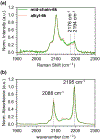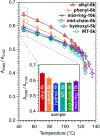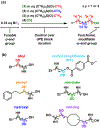Selective deuteration along a polyethylene chain: Differentiating conformation segment by segment
- PMID: 38841360
- PMCID: PMC11151874
- DOI: 10.1021/acs.macromol.3c01560
Selective deuteration along a polyethylene chain: Differentiating conformation segment by segment
Abstract
To improve the circularity and performance of polyolefin materials, recent innovations have enabled the synthesis of polyolefins with new structural features such as cleavable breakpoints, functional chain ends, and unique comonomers. As new polyolefin structures become synthetically accessible, fundamental understanding of the effects of structural features on polymer (re)processing and mechanical performance is increasingly important. While bulk material properties are readily measured through conventional thermal or mechanical techniques, selective measurement of local material properties near structural defects is a major characterization challenge. Here, we synthesized a series of polyethylenes with selectively deuterated segments using a polyhomologation approach and employed vibrational spectroscopy to evaluate crystallization and melting of chain segments near features of interest (e.g., end groups, chain centers, and mid-chain structural defects). Chain-end functionality and defects were observed to strongly influence crystallinity of adjacent deuterated chain segments. Additionally, chain-end crystallinity was observed to have different molar mass dependence than mid-chain crystallinity. The synthesis and spectroscopy techniques demonstrated here can be applied to range of previously inaccessible deuterated polyethylene structures to provide direct insight into local crystallization behavior.
Figures






References
-
- EMF. The New Plastics Economy: Rethinking the Future of Plastics & Catalysing Action. Ellen MacArthur Found. 2017.
Grants and funding
LinkOut - more resources
Full Text Sources
Research Materials
